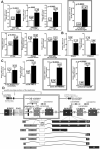A rare genomic duplication in 2p14 underlies autosomal dominant hearing loss DFNA58
- PMID: 32337552
- PMCID: PMC7268784
- DOI: 10.1093/hmg/ddaa075
A rare genomic duplication in 2p14 underlies autosomal dominant hearing loss DFNA58
Abstract
Here we define a ~200 Kb genomic duplication in 2p14 as the genetic signature that segregates with postlingual progressive sensorineural autosomal dominant hearing loss (HL) in 20 affected individuals from the DFNA58 family, first reported in 2009. The duplication includes two entire genes, PLEK and CNRIP1, and the first exon of PPP3R1 (protein coding), in addition to four uncharacterized long non-coding (lnc) RNA genes and part of a novel protein-coding gene. Quantitative analysis of mRNA expression in blood samples revealed selective overexpression of CNRIP1 and of two lncRNA genes (LOC107985892 and LOC102724389) in all affected members tested, but not in unaffected ones. Qualitative analysis of mRNA expression identified also fusion transcripts involving parts of PPP3R1, CNRIP1 and an intergenic region between PLEK and CNRIP1, in the blood of all carriers of the duplication, but were heterogeneous in nature. By in situ hybridization and immunofluorescence, we showed that Cnrip1, Plek and Ppp3r1 genes are all expressed in the adult mouse cochlea including the spiral ganglion neurons, suggesting changes in expression levels of these genes in the hearing organ could underlie the DFNA58 form of deafness. Our study highlights the value of studying rare genomic events leading to HL, such as copy number variations. Further studies will be required to determine which of these genes, either coding proteins or non-coding RNAs, is or are responsible for DFNA58 HL.
© The Author(s) 2020. Published by Oxford University Press. All rights reserved. F or Permissions, please email: journals.permissions@oup.com.
Figures









References
-
- NIDCD Epidemiology and Statistics Program Age at which hearing loss begins. Source: National Health Interview Survey, 2007https://www.nidcd.nih.gov/health/statistics/age-which-hearing-loss-begins(updated in November 2012).
-
- Bowl M.R. and Brown S.D.M. (2018) Genetic landscape of auditory dysfunction. Hum. Mol. Genet., 27, R130–R135. - PubMed
Publication types
MeSH terms
Substances
Grants and funding
LinkOut - more resources
Full Text Sources
Molecular Biology Databases

